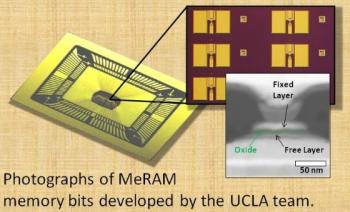UCLA researcher have managed to make major improves in MRAM memory by electric voltage instead of a flowing electric current (which is used in STT-MRAM). They call the new memory MeRAM (Magnetoelectric Random Access Memory). The researchers say that MeRAM combines extraordinary low energy with very high density, high-speed reading and writing times, and non-volatility.

By using voltage to write data into MeRAM's memory, there's no need to move large numbers of electrons through wires and so the writing generates much less heat - in fact MeRAM could be 10 to 1,000 times more energy-efficient than STT-MRAM. It's also five times as dense (more bits stored in the same physical area). This should hopefully make MeRAM cheaper, too.
UCLA explains that MeRAM uses nanoscale structures called voltage-controlled magnet-insulator junctions, which have several layers stacked on top of each other, including two composed of magnetic materials. However, while one layer's magnetic direction is fixed, the other can be manipulated via an electric field. The devices are specially designed to be sensitive to electric fields. When the electric field is applied, it results in voltage — a difference in electric potential between the two magnetic layers. This voltage accumulates or depletes the electrons at the surface of these layers, writing bits of information into the memory.